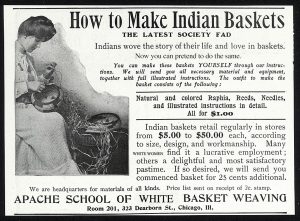
The image I would like to address today is a 1902 ad advertising an Indigenous basket weaving kit. In it, the title is depicted as: How to Make Indian Baskets: The Latest Society Fad. This advertisement offers to teach women how to make Indigenous baskets through an instruction booklet and materials with everything they need to make said baskets. From the very start these baskets are advertised as a cultural fad and commoditised into something that any person can easily make at home.
‘Indians wove the story of their life and love in baskets’ the ad reads ‘the making of them today is as much as an art as ever.’ It should be noted here that this ad is not aimed at Indigenous women themselves but at white women wishing to try and replicate these baskets as the ads picture displays not an Indigenous woman but a white one in period clothing working away at making a basket. ‘Many women find it a lucrative employment; others a delightful and satisfactory pastime,’ the ad continues. Advertising as fetching anywhere from 5-50$’ it promises the potential for earning money through the appropriation of the work of another culture. What this ad fails to acknowledge is the absurdity of colonial people making Indigenous baskets as art pieces for colonial homes. From the start this ad looks to monetize a ‘fad’ that is actually another groups culture and then it promises that you can cash in on it too. To end with the ad asks you to send away to the ‘Apache School of Indian Basket Weaving’ in an attempt replicate authenticity as if Indigenous peoples themselves were sending you the materials. While reading this I drew a lot of parallels between the urban outfitters smudge kit that they tried to turn into a commodity

The overall theme that I tried to draw in my culture jam was to turn attention to the commodification and appropriation of Indigenous culture. Because a lot of this ad already does the work itself I tried to highlight the areas where it was most blatant by actively changing the text into wording that was a little more obvious of the intentions of the ad.
I started off by changing the text ‘Indians wove the story of their life and love in baskets. The making them today is as much as an art as ever,’ to ‘Indians wove the story of their life and love in baskets. Now you can pretend to do the same,’ to highlight the ironicism that a basket making kit could do the same. I then changed the text from ‘many women find it lucrative employment’ to ‘many white women find it lucrative employment,’ to draw attention to the fact that this ad which is geared towards white women was telling them—and not indigenoys women—that they too could cash in on this fad. To finish I changed the ‘Apache School of Indian Basket Weaving,’ to ‘The Apache School of White Basket Weaving’ as a way of highlighting that Indigenous people were not part of this process in any way shape or form.
Overall in this culture jam I looked to take away the romanticized aspects of this ad to show how in fact it was white people commodifying and appropriating Indigenous baskets by romanticizing and turning them into a fad and then promising other White people that they too could cash in on this fad as well.